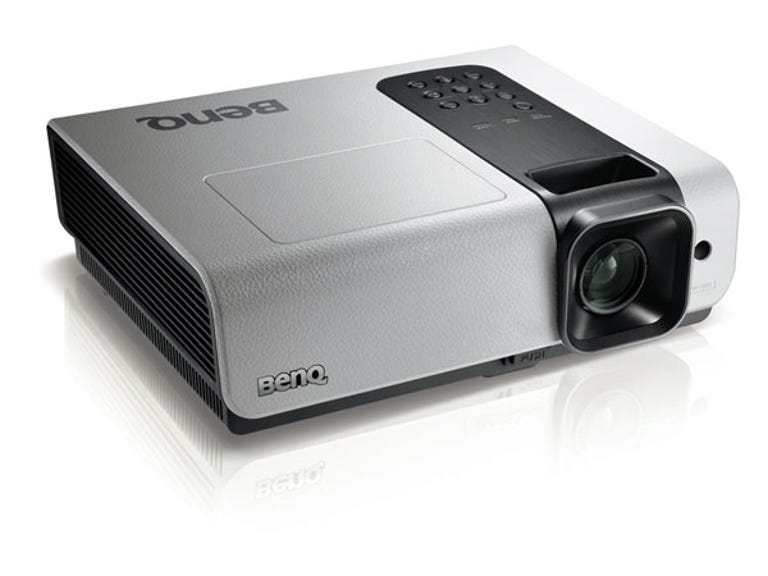 Why You Can Trust CNET
Why You Can Trust CNET BenQ W1000 review: BenQ W1000
The BenQ W1000 DLP projector can be had for the same price as a 42-inch LCD, but will give you better bang for your buck.
Seriously affordable and quality home theatre projection has been a BenQ forté of recent years — the brand has introduced more than its fair share of households to the delights of viewing at well over 50 inches. The company recently introduced some new projector models including one of the most affordable Full HD 1080p units available, so how does it stack up?
The Good
The Bad
The Bottom Line
Design and features
The W1000 is a slim and small affair compared to the 1080p projector bulk brigade and, like Optoma's equally compact HD20, takes up very little living space. It's a DLP-based design implementing a six-segment colour wheel (which should lessen any "rainbow effect") with BrilliantColor processing and 3D Color Management. These latter two features allow plenty of picture calibration, more on which later.
The lens controls include the usual zoom and focus; there's no manual shifting, so positioning and throw distances become important. We needed it a good 3.7 metres back from our 96-inch screen to fill it. There's a couple of feet that are adjustable to help level the W1000 if you're table mounting, but we found them quite fiddly and not all that helpful — it's necessary to sit the BenQ at the right sort of projection height as well to help best fit the screen.
Connectivity's good with plenty of inputs including the necessary two HDMI, supported by the usual component, VGA and AV inputs. There's a USB port too, but you can't use it for direct playback of snaps or movies from USB storage devices; it's there for external control duties only. Rather unexpectedly, there's a mono speaker built into the back alongside the connections, which you'll either use or not. It adds to the W1000's portability and makes a half reasonable sound with sufficient, distortion-free volume.
A small and basic backlit remote provides all of the armchair control and it works well too without having to be specifically pointing to the projector like some. The menu system is familiar from previous BenQ models and easily navigable, although we'd recommend any image changes you make are saved to one of the user settings immediately, otherwise they are easily lost and you'll have to start from scratch once more.
The specs aren't at all bad for this sort of entry-level price: HD projection, with BenQ rating the W1000's brightness at 2000 ANSI lumens, together with a realistic contrast ratio of 3000:1. Lamp life was given at 3000 hours in "Normal" mode and 4000 hours in "Economic" which is par for the course. One of the beauties of BenQ projection is the relatively low running costs — a new lamp will set you back around AU$300 and if it lasts as long as it's claimed, that's a pretty affordable long-term projection.
Performance
We didn't like what we saw straight out of the box one little bit — the default image was full of artefacts including some really visible "ghosting" around the edges of hard colours. These strong colours also looked totally oversaturated and generally things looked like we were entertaining a very average SD projector, not one able to handle 1080p HD material.
Knowing BenQ projectors we (rightly) assumed this shouldn't be the norm and after several picture adjustments, finally ended up with an image that had us thinking "that's more like it". First, we dropped the sharpness way back to zero, adjusted the gamma setting and turned a control called "Luma Transmission" to zero. Colour temperature was set to "Cool" and things were starting to appear much better. But the single biggest improvement to the picture came when we switched the BrilliantColor off — bang, away went those horrible-looking ghosting effects and the whole image snapped back into a much sharper focus. Less is definitely more in the W1000's case.
There was always ample light output from the BenQ, even in "Economic" mode and it handled some ambient room light without any trouble. In "Normal" mode it's brighter still and once again ample for a larger screen, but the fan tends to work overtime and the BenQ is a bit noisier than others, so bear this in mind. Watching the rather bright and colourful (but equally naff) Fool's Gold the W1000 puts in a respectable performance with this well-transferred Blu-ray disc (BD). It lacks that visual punch of the likes of Sony's excellent VPLHW15 and Epson's EH-TW3500, but there's still plenty of vibrancy and solid colours regardless. There was also none of the softness or noise that you tend to get with your average 720p DLP projector, which still cost around the same as this one.
We took delivery of a copy of Avatar during this review and couldn't resist a peek at the quality this BD has to offer (and no doubt it'll become a much used test disc simply because of its sumptuous use of colours and super schmick HD transfer). It certainly brought out the BenQ's best as the projector handled the vivid colours of Pandora's forests and resident beasts admirably. Once again there wasn't the sheer levels of finer shadow detail nor depths of blacks conjured up by dearer 1080p offerings, but we were impressed by the way the BenQ handled itself overall, without any noticeable image artefacts or sign of the dreaded "rainbow effect".
Conclusion
Bang for buck, this 1080p projector from BenQ offers plenty of visual appeal. It's not got the punch of more expensive models nor is it the most flexible with its positioning, but for an affordable, transportable HD option it's hard to argue with its value for money. Shop around and you'll pick one up for around AU$1500 — the same money as most 42-inch flat panel TVs. Now which would you prefer?
